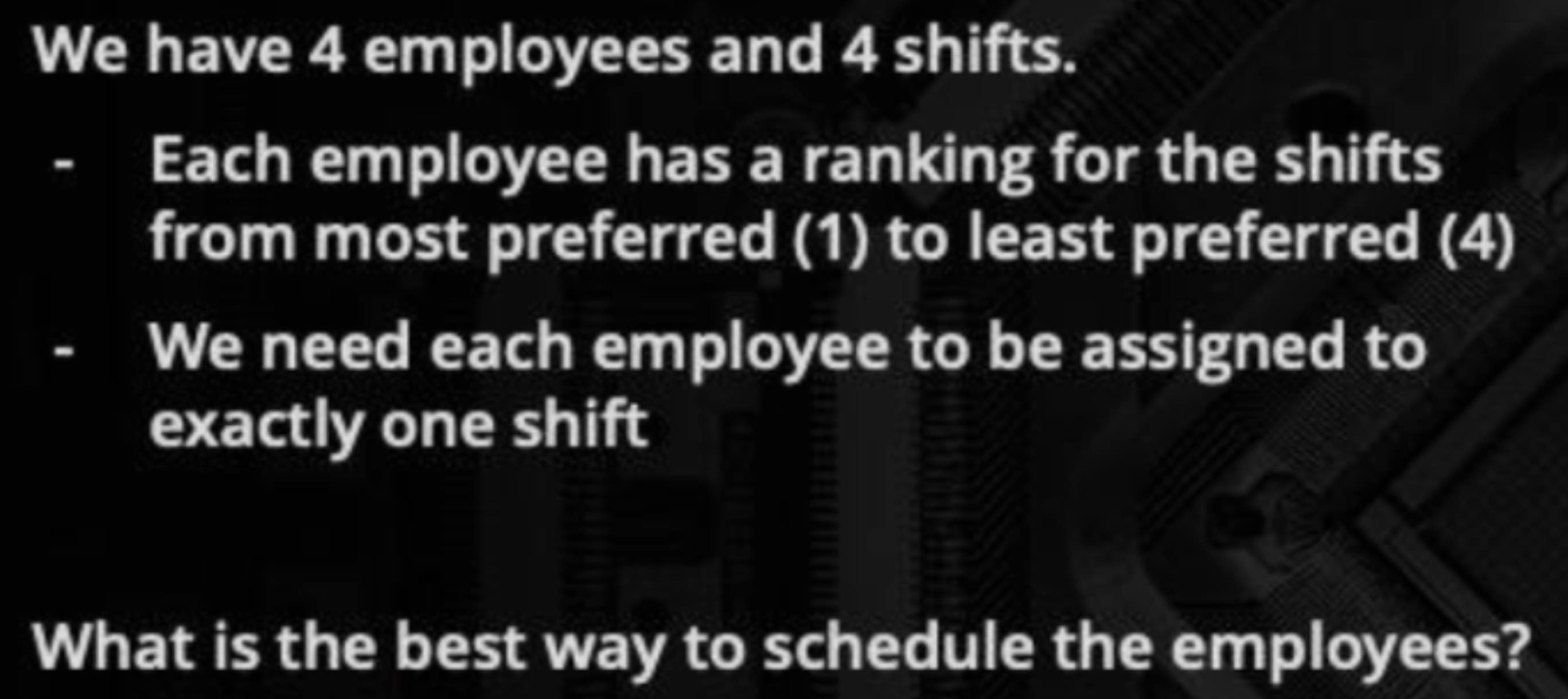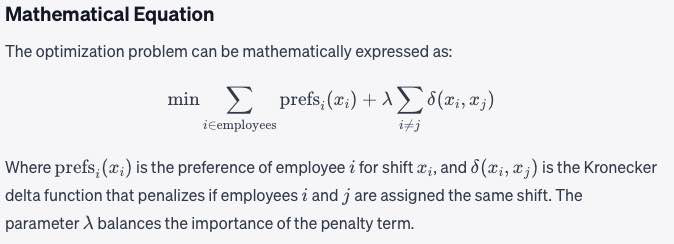To address the scheduling problem for the 4 employees and 4 shifts based on their preferences, you can use a Discrete Quadratic Model (DQM) to find the optimal assignment.
from dimod import DiscreteQuadraticModel
from dwave.system import LeapHybridDQMSampler
# Initialize DQM object
dqm = DiscreteQuadraticModel()
# Employee names and their shift preferences
employees = {
"Anna": [1, 2, 3, 4],
"Bill": [3, 2, 1, 4],
"Chris": [4, 2, 3, 1],
"Diane": [4, 1, 2, 3]
}
# Number of shifts
num_shifts = 4
# Add variables and preferences
for name, prefs in employees.items():
dqm.add_variable(num_shifts, label=name)
dqm.set_linear(name, prefs)
# Quadratic terms to enforce one shift per employee
for name1 in employees:
for name2 in employees:
if name1 != name2:
biases = {(i, j): 1 for i in range(num_shifts) for j in range(num_shifts)}
dqm.set_quadratic(name1, name2, biases)
# Sample
sampler = LeapHybridDQMSampler()
sampleset = sampler.sample_dqm(dqm)
best_solution = sampleset.first.sample
# Show best shift assignment
for name, shift in best_solution.items():
print(f"{name} is assigned to shift {shift+1}")The optimization problem can be mathematically expressed as:
[ \min \sum_{i \in \text{employees}} \text{prefs}i(x_i) + \lambda \sum{i \neq j} \delta(x_i, x_j) ]
Where ( \text{prefs}_i(x_i) ) is the preference of employee ( i ) for shift ( x_i ), and ( \delta(x_i, x_j) ) is the Kronecker delta function that penalizes if employees ( i ) and ( j ) are assigned the same shift. The parameter ( \lambda ) balances the importance of the penalty term.
This code should output the best assignment of employees to shifts according to their preferences.
from dimod import DiscreteQuadraticModel
# Initialize DQM object
dqm = DiscreteQuadraticModel()In our case, each employee can take one of the four shifts. Therefore, each variable (employee) will have four cases (shifts).
# Employee names
employee_names = ["Anna", "Bill", "Chris", "Diane"]
# Number of shifts
num_shifts = 4
# Add variables
for name in employee_names:
dqm.add_variable(num_shifts, label=name)Linear biases represent the preferences each employee has for each shift. The lower the value, the more preferable the shift is for the employee.
# Employee preferences for each shift
employee_preferences = {
"Anna": [1, 2, 3, 4],
"Bill": [3, 2, 1, 4],
"Chris": [4, 2, 3, 1],
"Diane": [4, 1, 2, 3]
}
# Add linear biases based on preferences
for name, prefs in employee_preferences.items():
dqm.set_linear(name, prefs)For adding the linear biases, the mathematical expression can be considered as:
[ E(\text{shift}) = \sum_{i \in \text{Employees}} \text{Preference}_{i}(\text{shift}) ]
where ( \text{Preference}_{i}(\text{shift}) ) is the preference score for employee ( i ) for a particular shift. We try to minimize ( E ) to get the optimal schedule.
Combine these steps to create a full DQM model for solving your employee scheduling problem. After these steps, you would usually add the quadratic terms and then sample the DQM to find the optimal assignment.


